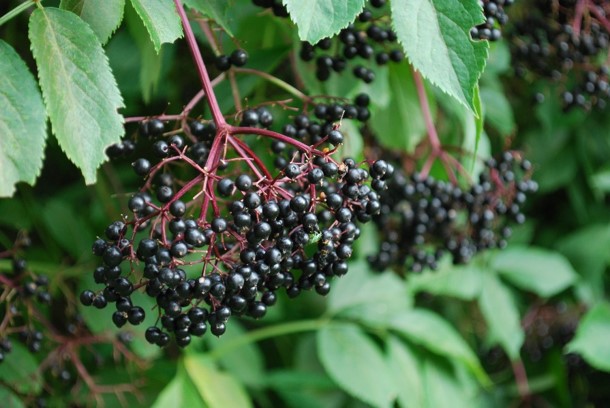Edible Natives to Grow This Season
Another way to think of native edibles is to think of them as wild foods. Since they’ve adapted themselves to your region without human interference, they’re ready for your soil type, rainfall conditions, annual temperatures, and already resistant to many pests and diseases. But instead of foraging for these plants, leave them for local wildlife and harvest your own sown supply from your backyard.
Beyond diet diversity, edible natives also encourage us to eat seasonally—after all, you can’t forage what isn’t growing! So what to grow? Think about the mushrooms, herbs, and berries that grow around you and go from there, or consult books like this one to get some ideas.
Try cultivating stinging nettles (Urtica dioica) and harvest the young shoots. Sauté them, throw them in a soup, or brew as a nutrient-dense tea—but remember not to eat them raw and to wear gloves when harvesting. Dandelion greens, clover, and chickweed—all commonly considered weeds—are wonderful early-spring salad additions, too. Since they’re so plentiful, why not harvest while weeding? Beebalm (Monarda species) leaves and flowers make a wonderful tea, as do mountain mints (Pycnanthemum species).
Try highbush blueberry (Vaccinium corymbosum) for their sweet blooms and edible fruits, or grow cranberry (Vaccinium macrocarpon). Beach plum (Prunus maritima) fruits make wonderful jams, jellies, and sauces. Black chokeberry (Aronia melanocarpa) is an edible hedge whose berries are incredibly high in antioxidants. American elderberry (Sambucus canadensis), black huckleberry (Gaylussacia baccata), and wild raisin, also known as witherod, (Viburnum nudum var. cassinoides) are a few more examples.
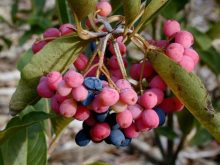 Wild raisin (Viburnum nudum var. cassinoides)
Wild raisin (Viburnum nudum var. cassinoides)
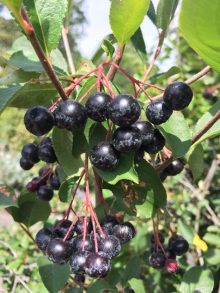 Black chokeberry (Aronia melanocarpa)
Black chokeberry (Aronia melanocarpa)
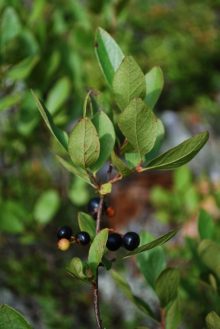 Black huckleberry (Gaylussacia baccata)
Black huckleberry (Gaylussacia baccata)
Named Maine’s State Herb in 1999, wintergreen (Gaultheria procumbens) is a groundcover whose berries are a good winter food source for birds and mammals and whose leaves can be made into a poultice or massage oil for aching muscles and joints. Spicebush (Lindera benzoin) berries can be dried, ground, and used like allspice—bonus, they support the spicebush swallowtail butterfly.
Or think about fruit and nut trees and grain sources. Sow Canada wild rye (Elymus canadensis) and harvest and dry the berries—you can grind these into flour. You can’t go wrong with a harvest of American hazelnuts (Corylus americana), either. Of course, there’s sugar maple (Acer saccharum) for all of your spring syrup-ing needs.
Or try something totally new—what about a tuber that’s perennial, native, AND has three times the protein of a potato? Groundnuts (Apios americana) are your answer. Pawpaw (Asimina triloba) is a fruit that tastes like a cross between bananas, mangoes, and kiwis. Or try persimmon (Diospyros virginiana). Both are interesting fruits with plenty of applications from chutneys to pies to puddings and even fruit beers. Speaking of which—not sure what to do with your harvest? Books like Notes from a Maine Kitchen and The Elderberry Book might give you places to start.
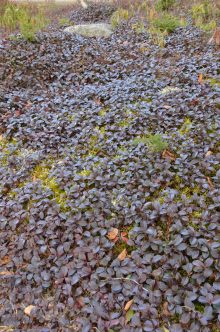 Wintergreen (Gaultheria procumbens)
Wintergreen (Gaultheria procumbens)
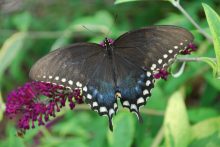 Spicebush swallowtail butterfly
Spicebush swallowtail butterfly
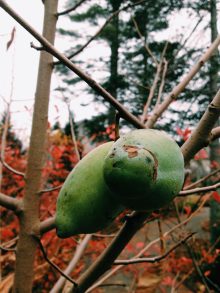 Pawpaw (Asimina triloba)
Pawpaw (Asimina triloba)
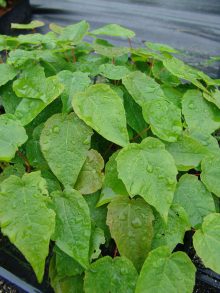 Sugar maple (Acer saccharum) seedings
Sugar maple (Acer saccharum) seedings
Excited by possibility? Now is the perfect time to get planning—there are plenty of native plant adventures to go on, and this is definitely not an exhaustive list. Just remember to get your seeds from a trusted, ethical, and ecologically responsible source like Wild Seed Project (and NOT from the wild). If you’re a landscape professional, you might be interested in our upcoming class in partnership with the Maine Organic Farmers and Gardeners Association (MOFGA), Propagating and Sowing Native Edible Plants on March 8. Happy foodscaping!
Thank you to Andy Brand, Director of Horticulture, and Katherine Brewer, Curator of Living Collections, for their assistance on this post!
